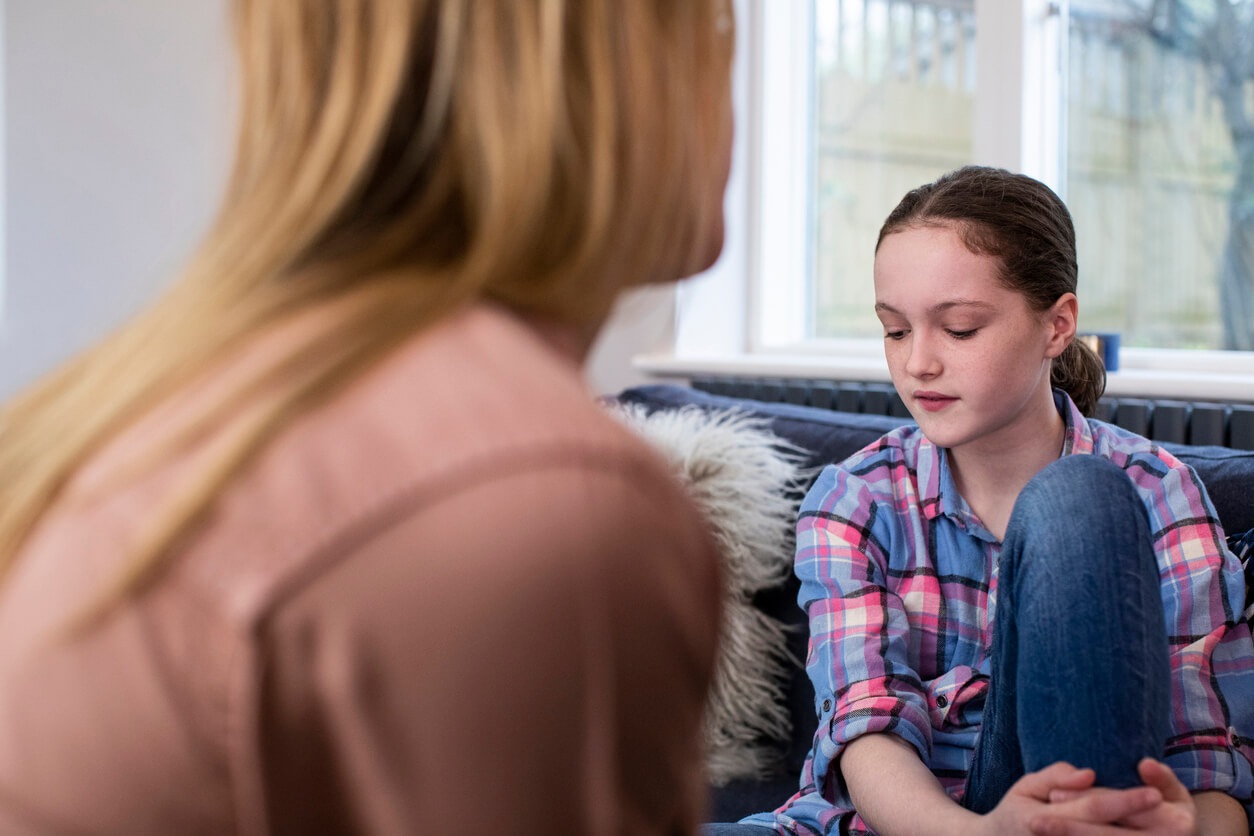The Main Challenges During Preadolescence


Written and verified by the psychologist Sharon Capeluto
Preadolescence is a transitional stage. We can also think of it as an ambiguous time, both physically and psychologically. What do we mean by this? Preadolescents are no longer innocent children with small bodies, but neither are they adolescent rebels ready to confront the social system or authority figures. In the following article, we’ll talk about the main challenges during preadolescence.
What is preadolescence?
We could define preadolescence, approximately, as the period between 9 and 13 years of age. Of course, it’s not a stage exclusively determined by biological age. It depends on different variables, such as the level of psychological, physical, and sexual maturation of each individual, as well as their social and historical context.
Once the sexual characteristics of children begin to appear, we say that they stop being children and gradually transform into young adolescents.

These are the main challenges during preadolescence
In the following paragraphs, we’ll focus on locating the main challenges during preadolescents in order to try to understand them better.
Sexual and emotional maturation
This is one of the most relevant points of preadolescence. Those of us who’ve already gone through this stage know very well how complex it is to notice that we’re growing hair in some areas where we didn’t have it before, that our hips widen, or that our voice is no longer the same. Not to mention a girl’s first menstruation.
Generally, physical and hormonal changes are perceived as disruptive elements that lead to emotional stability. Psychological maturation is usually slower and more progressive. At the same time, the manifestations of sexual maturation are so abrupt that they don’t seem to allow enough time to process them psychologically. Consequently, preadolescence, who until then were children, have no choice but to adapt to their new bodies.
Mourning childhood
From any perspective, this is a particularly fragile and vulnerable stage. Symbolic losses take center stage. Preadolescence is experienced as a mourning of childhood. As they grow up, the innocence and naivety of children begin to be lost.
It’s an intermediate zone that’s full of contradictions. At times, they want to play like children and, at other times, they prefer to do activities that are more associated with adolescence, such as going out with friends at night. Therefore, there are at least three mourning processes:
- Mourning the loss of your childhood body
- Mourning the loss of your childhood identity
- Mourning your childhood parents
“This is a fragile age, which has been defined as a phase of mutation, as adolescents must leave something of themselves behind and go through a change that’s difficult to assimilate and about which they can say nothing”.
– Correa-Tapia, M. A –

The search for independence is one of the main challenges during preadolescence
At the age of nine, ten, or eleven, it’s natural for children to begin to conquer autonomous spaces and distance themselves from their families. The search for independence is usually very noticeable and even generates a lot of uncertainty and anguish in parents. This is when they become concerned about the number of hours their teenagers spend locked in their room. Also, they wonder why they’ve stopped participating in family gatherings. It’s difficult to accept that children are no longer little creatures.
In turn, preadolescents have ambivalent feelings about emancipation, which needs to be achieved progressively. On the one hand, they seek to reaffirm their subjective identity by venturing into the outside world, away from their parents. This is useful for them to gain confidence and acquire skills to relate to others, as well as to overcome conflicts by their own means.
However, exogamic exploration doesn’t come without its share of insecurity. Therefore, at times, they also need the guidance and approval of their adult role models.
A stage full that’s of changes
As we can see, preadolescence is a period characterized by metamorphosis. At this stage, the body, interests, concerns, and needs of children change. Also, there’s an intense desire to conquer personal spaces, and the need to uproot oneself from the family nucleus becomes fundamental. At this time, preteens begin to see their parents as more imperfect and more human, so they can stop idolizing them.
In short, preadolescents are in the complex process of becoming free. And while freedom brings great benefits such as a sense of independence and security, it also imparts great responsibility.
Preadolescence is a transitional stage. We can also think of it as an ambiguous time, both physically and psychologically. What do we mean by this? Preadolescents are no longer innocent children with small bodies, but neither are they adolescent rebels ready to confront the social system or authority figures. In the following article, we’ll talk about the main challenges during preadolescence.
What is preadolescence?
We could define preadolescence, approximately, as the period between 9 and 13 years of age. Of course, it’s not a stage exclusively determined by biological age. It depends on different variables, such as the level of psychological, physical, and sexual maturation of each individual, as well as their social and historical context.
Once the sexual characteristics of children begin to appear, we say that they stop being children and gradually transform into young adolescents.

These are the main challenges during preadolescence
In the following paragraphs, we’ll focus on locating the main challenges during preadolescents in order to try to understand them better.
Sexual and emotional maturation
This is one of the most relevant points of preadolescence. Those of us who’ve already gone through this stage know very well how complex it is to notice that we’re growing hair in some areas where we didn’t have it before, that our hips widen, or that our voice is no longer the same. Not to mention a girl’s first menstruation.
Generally, physical and hormonal changes are perceived as disruptive elements that lead to emotional stability. Psychological maturation is usually slower and more progressive. At the same time, the manifestations of sexual maturation are so abrupt that they don’t seem to allow enough time to process them psychologically. Consequently, preadolescence, who until then were children, have no choice but to adapt to their new bodies.
Mourning childhood
From any perspective, this is a particularly fragile and vulnerable stage. Symbolic losses take center stage. Preadolescence is experienced as a mourning of childhood. As they grow up, the innocence and naivety of children begin to be lost.
It’s an intermediate zone that’s full of contradictions. At times, they want to play like children and, at other times, they prefer to do activities that are more associated with adolescence, such as going out with friends at night. Therefore, there are at least three mourning processes:
- Mourning the loss of your childhood body
- Mourning the loss of your childhood identity
- Mourning your childhood parents
“This is a fragile age, which has been defined as a phase of mutation, as adolescents must leave something of themselves behind and go through a change that’s difficult to assimilate and about which they can say nothing”.
– Correa-Tapia, M. A –

The search for independence is one of the main challenges during preadolescence
At the age of nine, ten, or eleven, it’s natural for children to begin to conquer autonomous spaces and distance themselves from their families. The search for independence is usually very noticeable and even generates a lot of uncertainty and anguish in parents. This is when they become concerned about the number of hours their teenagers spend locked in their room. Also, they wonder why they’ve stopped participating in family gatherings. It’s difficult to accept that children are no longer little creatures.
In turn, preadolescents have ambivalent feelings about emancipation, which needs to be achieved progressively. On the one hand, they seek to reaffirm their subjective identity by venturing into the outside world, away from their parents. This is useful for them to gain confidence and acquire skills to relate to others, as well as to overcome conflicts by their own means.
However, exogamic exploration doesn’t come without its share of insecurity. Therefore, at times, they also need the guidance and approval of their adult role models.
A stage full that’s of changes
As we can see, preadolescence is a period characterized by metamorphosis. At this stage, the body, interests, concerns, and needs of children change. Also, there’s an intense desire to conquer personal spaces, and the need to uproot oneself from the family nucleus becomes fundamental. At this time, preteens begin to see their parents as more imperfect and more human, so they can stop idolizing them.
In short, preadolescents are in the complex process of becoming free. And while freedom brings great benefits such as a sense of independence and security, it also imparts great responsibility.
All cited sources were thoroughly reviewed by our team to ensure their quality, reliability, currency, and validity. The bibliography of this article was considered reliable and of academic or scientific accuracy.
- Correa-Tapia, M. A. (2012). Los avatares de la pre-adolescencia: conflictos y propuestas para su transición. Boletín Científico Sapiens Research, 2(1), 31-35.
- Mancilla Medina, A., Vázquez Arévalo, R., Mancilla Díaz, JM., Amaya Hernández, A., & Álvarez Rayón, g., (2012). Insatisfacción corporal en niños y preadolescentes: Una revisión sistemática. Revista mexicana de trastornos alimentarios, 3(1), 62-79. Recuperado en 01 de diciembre de 2022, de http://www.scielo.org.mx/scielo.php?script=sci_arttext&pid=S2007-15232012000100008&lng=es&tlng=es.
This text is provided for informational purposes only and does not replace consultation with a professional. If in doubt, consult your specialist.








